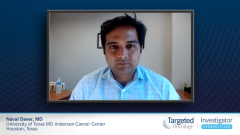
Diagnosis of Myelodysplastic Syndrome
A key opinion leader describes how myelodysplastic syndrome is diagnosed, the typical presenting symptoms, and the methods of risk assessment.
Episodes in this series
Naval Daver, MD: The diagnosis of
In addition to just knowing if a patient has MDS or not, we really want to know what the chromosome and molecular state of the patient is, because there is no longer a one-size-fits-all therapy for MDS. The therapies are really tailored based on the underlying molecular mutations, and we now have targeted therapies both in MDS and AML [acute myeloid leukemia] for several different mutations. If patients have a FLT3 mutation, we have FLT3 inhibitors that are very effective, whether given as a single agent or in combination with other drugs. If they have an IDH1/IDH2 mutation, we have IDH1/IDH2 inhibitors, which are also very effective. If they have a TP53 mutation, then standard therapies often do not work, and we may consider using novel therapies like CD47 or other immune-based approaches.
In addition to knowing if a patient has MDS, what is the blast percentage, what is the degree of dysplasia, which cell lines are dysplastic, at the [University of Texas] MD Anderson Cancer Center we usually send off a large molecular panel, we call it the 81-gene panel, that will give us a lot of genomic information that has both prognostic value and also predictive value in selecting the best treatment. As we discussed initially, cytogenetics are the most important for the prognosis, so we also want to get that cytogenetic information very early.
When we are checking for cytogenetic and molecular features in a patient, usually the first thing we will have available is the cytogenetic information. There are 2 ways to look at cytogenetics. One is by what we call routine karyotype, which provides the entire cytogenetic information for the chromosomes of that patient. Second is what we call a FISH [fluorescence in situ hybridization] probe that will look at specific targeted cytogenetic abnormalities, usually ones that are known to be most common in MDS.
The IPSS-R [Revised International Prognostic Scoring System] usually buckets these cytogenetic abnormalities into 3 big groups. One is called a favorable group; this includes patients who have cytogenetic abnormalities like deletion 20q. The next is an intermediate group, and then there’s the unfavorable or high-risk group that includes cytogenetic abnormalities like deletion 5, deletion 7q, deletion 17, and chromosome 1 and 3 abnormalities. Everything else falls into the intermediate group. At our center, we usually try to get this information within 3 to 5 days, and it helps us understand if this patient has favorable, intermediate, or adverse cytogenetics. This also plays into the eventual IPSS-R score, and the decision about whether we will be considering allogeneic stem cell transplant for that patient.
The second piece of information is the molecular mutation information; this takes a little bit longer, about 5 to 6 days for us to get the full 81-gene molecular mutation panel. In this, the 5 or 6 important mutations we’re looking for are FLT3, IDH1/IDH2, TP53, MLL rearrangement, and now new mutations like CBL and KIT, for which also there are targeted therapies. We usually find in about 20% to 30% of patients a targetable mutation that will change our initial therapeutic decision, moving us to a targeted therapy combination, which usually has a better outcome if there is a targetable mutation. These are the 2 important sets of information.
One of the things we have noticed often in patients coming to us from smaller community sites, is they may not have the full mutation information, or they may have very limited mutational data. Often, we are able to pick up mutations that were not known or identified outside that actually change the treatment choice by giving us a new target that has been identified. I think getting this information is really critical to selecting the treatment choice.
Transcript edited for clarity.









































